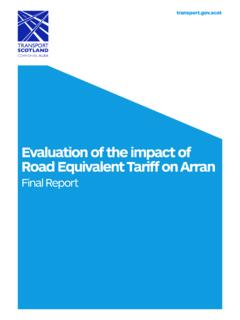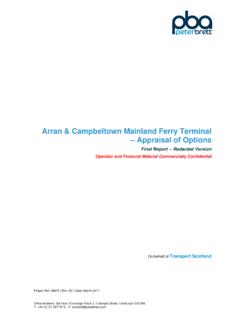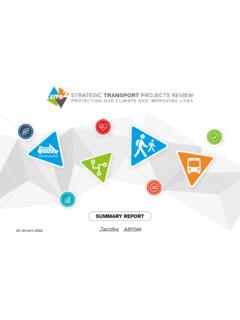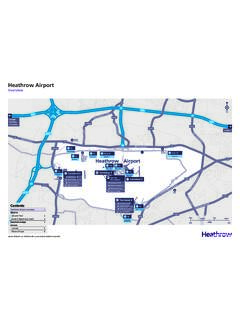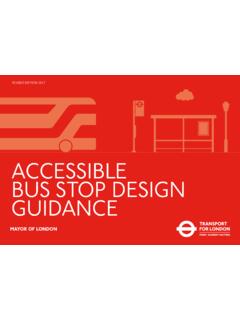Transcription of Roads for All: Good Practice Guide for Roads
1 Roads for All: good Practice Guide for Roads Crown copyright 2013 You may re-use this information (not including logos) free of charge in any format or medium, under the terms of the Open Government Licence. To view this licence, visit or write to the Information Policy Team, The National Archives, Kew, London TW9 4DU, or e-mail: This document/publication is also available on our website at ISBN: 978-1-908181-72-5 The Scottish Government St Andrews House Edinburgh EH3 3DG Published by the Scottish Government, July 2013 Roads for All: good Practice Guide for Roads Amendments sheet Date Amendment July 2013 Chapter 2: Disability Discrimination Legislation and Disabled People Section : text updated regarding the Equality Act (2010) Chapter 3: Meeting the Needs of Disabled People Section : website address added for Scottish Disability Equality Forum and text updated regarding the Equality Act (2010) Section : introduction of Accessibility Audit System Chapter 4: Design Standards Section.
2 Text added regarding access to and layout of bus lay-bys Section : text added regarding access to and layout of in-line bus stops, with reference to raised boarding kerbs Section : text added regarding puffin crossings Section : DMRB reference corrected to TD 36/93 Section : text added regarding puffin crossings Section : number added to table Section : text added regarding shared pedestrian/cycle routes Section : text added indicating the correct placement of lighting columns Figures 1, 2a, 2b, 3a, 3b: lay-by signage and road markings revised for accessible bay to be in accordance with TSRGD Figure 4: bus lay-by detail amended to include hard strip as per DMRB Figure 5: note added regarding position of bus stop flag Figure 6: controlled crossing changed to puffin type Figures 7a and 7b: minimum crossing widths added Figure 11: controlled crossing changed to puffin type Figure 15: vehicle give way markings corrected and access context added Figure 25: diagram amended to indicate a variety of tonal contrast examples Figure 26b: road markings revised for accessible on-street parallel parking bay to be in accordance with TSRGD Roads for All: good Practice Guide for Roads Figure 29, 30, 31: tactile paving and double transition kerbs deleted from layout for emergency telephone access Chapter 5: Construction, Operation and Maintenance Figure 32: controlled crossing changed to puffin type Section : text revised regarding projections over footways Section : text revised regarding obstructing footways Section : text revised regarding legalities of unauthorised use of accessible parking bays Section : text revised regarding foliage overhanging the footway Chapter 6: Accessibility Audit System Accessibility Audit System introduced Appendices Appendix A.
3 Reference added to on-line directory of local Access Panels, and default adoption of GPG standards clarified in diagram Appendix B: further reading and references updated Roads for All: good Practice Guide for Roads CONTENTS COMMENTS ACKNOWLEDGEMENTS 1 INTRODUCTION 1 2 DISABILITY DISCRIMINATION LEGISLATION AND DISABLED PEOPLE 3 Legislative Background 3 Disabled People 4 3 MEETING THE NEEDS OF DISABLED PEOPLE 5 Introduction 5 Involvement 5 Access Champion 5 Equality Impact Assessments and Test of Reasonableness 5 Existing Guidance and Standards 6 Implementation 6 good Practice Guide Departures from
4 Standard 6 Accessibility Audit System 6 4 DESIGN STANDARDS 7 road Link Features 7 Introduction 7 Lay-bys 7 parking Lay-bys (Type A) 7 parking Lay-bys (Type B) 8 parking Lay-bys (Type A Lay-by with Trading Facility) 9 Bus Lay-bys 10 Bus Stops (In-line) 11 Controlled Pedestrian Crossings 11 Dropped Kerbs 12 Footway Width 13 Headroom 14 Crossfall 14 Longitudinal Gradients 14 Landings (Rest Points) 15 Shared Pedestrian/Cycle Routes 15 Surfacing Materials 16 Junctions 16 Introduction 16 Signalised Junctions 16 Major/Minor Priority Junctions 17 Roundabouts 19 Vehicle Access to the road (Vehicle Footway Crossovers)
5 19 Steps and Ramps 21 Introduction 21 Ramps 21 Steps Dimensions 22 Steps Tapered Risers 22 Steps Nosings 22 Handrails 23 Tactile Surfaces 24 Introduction 24 Roads for All: good Practice Guide for Roads Tactile Surfaces 24 Street Furniture/Ancillary Equipment 30 Introduction 30 Street Furniture 30 Designing for Tonal Contrast 32 seating 33 Signage 33 Lighting 34 Rest Areas 34 parking 34 Toilets 35 Emergency Telephones 37 5 CONSTRUCTION, OPERATION AND MAINTENANCE 41 Introduction 41 Construction 41 Traffic Management 41 Traffic Management Design 41 Construction Quality Control 42 Operational Issues 43 Advertising Boards 43 Pavement Caf s 44 Projections 44 Obstructing the Footway 45 Unauthorised Use of accessible Bays 45 Maintenance 45 Foliage 45 Footway Surfaces 46 6 ACCESSIBILITY AUDIT SYSTEM 47 Introduction 47 Implementation and Background 47
6 Accessibility Audit Objectives 47 Which Schemes To Audit 48 Accessibility Audit Structure 48 Structure 48 Objectives Setting and Context Report 48 Preliminary and Detailed Design Audit (Stage 1 & 2 Accessibility Audits) 48 Post-Construction Audit (Stage 3 Accessibility Audit) 49 Roles and Responsibilities 50 Transport Scotland Project Sponsor 50 Design Team Leader 51 Design Team Accessibility Auditor 51 Objectives Setting Stage and Context Report 52 Background 52 Procedure 52 Outputs and Approvals 53 Stage 1 & 2 Preliminary and Detailed Design Accessibility Audits 55 Background 55 Procedure 55 Output and Approvals 55 Stage 3 Post-Construction Accessibility Audit 58 Background
7 58 Procedure 58 Output and Approvals 60 Roads for All: good Practice Guide for Roads APPENDIX A EQUALITY IMPACT ASSESSMENT AND TEST OF REASONABLENESS - GUIDANCE FOR PROJECT TEAMS APPENDIX B FURTHER REFERENCES Roads for All: good Practice Guide for Roads COMMENTS As with other design standards and advice documents, the good Practice Guide will be updated regularly to take account of experience. Any comments on the document should be forwarded to the following address: Transport Scotland Standards Branch Buchanan House 58 Port Dundas road Glasgow G4 0HF Email: Roads for All: good Practice Guide for Roads ACKNOWLEDGEMENTS The good Practice Guide has been produced by Transport Scotland for use on Scotland s trunk road and motorway network. It is commended to all Scottish local road authorities.
8 Transport Scotland is grateful to Halcrow Group Limited and to the Roads For All Forum for all their assistance and helpful advice in producing the Guide . In particular the following organisations are thanked for their input: Mobility and Access Committee for Scotland (MACS); Scottish Disability Equality Forum (SDEF); Scottish accessible Transport Alliance (SATA); Inclusion Scotland; Action on Hearing Loss; Scottish Council on Deafness (SCOD); Society of Chief Officers for Transportation in Scotland (SCOTS); Confederation of Passenger Transport (CPT); Association of Chief Police Officers in Scotland (ACPOS) and People Friendly Design. Roads for All: good Practice Guide for Roads Page intentionally left blank Roads for All: good Practice Guide for Roads 1 1 INTRODUCTION This good Practice Guide contains Transport Scotland s requirements for inclusive design in the construction, operation and maintenance of road infrastructure. Inclusive design is an approach which aims to create environments which can be used by everyone regardless of age or disability.
9 The Guide provides practitioners with current international good Practice and advice on providing for the needs of people with sensory, cognitive and physical impairments, within the road environment. Where the guidance and design standards presented here conflict with the Design Manual for Roads and Bridges (DMRB), this good Practice Guide takes precedence. For implementation and Departures from Standard refer to Section and Section The good Practice Guide is targeted at everyone who makes design and management decisions which affect the road network. This includes external consultants and contractors as well as Transport Scotland staff. Production of the good Practice Guide is one of the objectives of Transport Scotland s Trunk road Disability Equality Scheme and Action Plan, Roads for All , published in December 2006. The Action Plan sets out the following objectives: To make Scotland s trunk road network safer and more accessible for all users by the removal of barriers to movement along and across trunk Roads ; To develop all professional and technical staff involved in the design, construction, operation, and maintenance of the trunk road network to recognise and understand the needs of disabled people; To ensure the design, construction, operation, and maintenance of the trunk road network meets the needs of disabled people through the involvement of disabled people in the development of good Practice guidance; To make facilities and services more accessible from the trunk road network; To make journeys secure and comfortable for all by working with other service providers and utilising appropriate technology.
10 To promote journeys by public transport by working with local authorities, regional transport partnerships and operators to improve access, facilities and information at bus stops etc. directly accessed from trunk Roads . It should be noted that in order to take full account of the needs of disabled people legislation permits treating disabled people more favourably than others. 1 Roads for All: good Practice Guide for Roads 2 Page intentionally left blank Roads for All: good Practice Guide for Roads 3 2 DISABILITY DISCRIMINATION LEGISLATION AND DISABLED PEOPLE Legislative Background The Disability Discrimination Act (1995) placed a duty on employers, educators and service providers to make reasonable adjustments to avoid discriminating against disabled people. This included making adjustments to physical features which act as barriers to access for disabled people. Public functions were not covered by this Act. The Disability Discrimination Act (2005) amended the 1995 Act and extended the principles of Part III, which prohibited discrimination in the provision of goods, facilities and services and premises, to the delivery of public authority functions.

